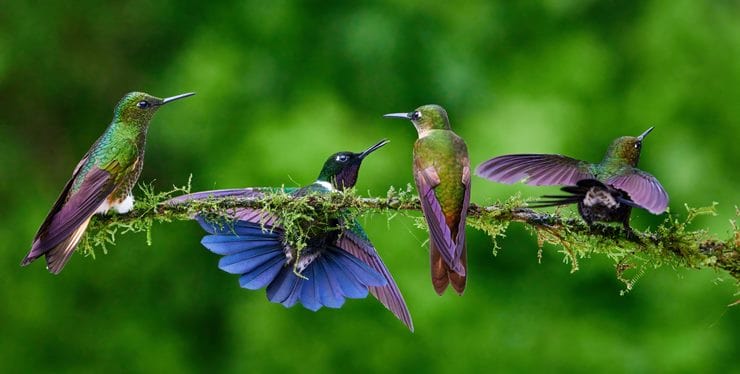
Table of Contents
Hummingbirds are in the family Trochilidae and are some of the smallest birds on the planet. These birds are native to the North and South American continents. Out of more than 350 species and 100 genera, most live at or around the equator in the tropics.
The smallest hummingbird is the Bee Hummingbird at 5 centimeters (2 inches) in length and less than 2 grams (0.07 ounces) in weight. The largest hummingbird species is the Giant Hummingbird which averages 21 grams (0.74 ounces) in weight and 23 centimeters (9 inches) in length.
Hummingbirds feed on nectar with their long, dagger-like bill. They also catch small insects that are on the flowers on which they feed. In addition to insects and nectar, hummingbirds ingest some pollen, sap, fruit, and ashes to complement their diet.
These birds often zip around feeding and chattering in noisy groups. Typically, hummingbirds chase others away from food sources. At other times they cluster together in groups around a rich food source. These groups of hummingbirds are often referred to as a charm.
Other common collective nouns include shimmer and bouquet, likely because of their bright, iridescent colors.
Less common but equally creative collective nouns include:
- Chattering
- Drum
- Glittering
- Tune
- Troubling
- Hover
Hummingbirds cannot smell food, but their vision is excellent. They typically search for flowers in shades of red, purple, pink, and orange. These birds usually sip from more than one thousand flowers per day.
What is a Group of Baby Hummingbirds Called?
A group of baby hummingbirds does not have a specific collective noun. Depending on their life stage, they are typically referred to by the common names of hatchlings, chicks, nestlings, and fledglings.
Female hummingbirds build cup-shaped nests on the branches of trees and shrubs. Some hummingbird species build nests small enough that they can even fit onto a leaf. Spider silk and lichen are used to construct the nest and hold it together.
Mother birds lay two eggs in the nest and incubate them for two to three weeks. Once hatched, chicks are fed a mix of nectar and small insects until they are ready to leave the nest. After about three weeks, the chicks leave the nest to begin feeding on their own.
Sometimes, the mother feeds the fledglings for up to three weeks after they leave the nest. Once fledglings leave the nest and cease being supported by their mother, they become solitary.
What is a Pair of Hummingbirds Called?
Male and female hummingbirds do not mate for life and only briefly spend time together during the breeding season. As a result, there is no specific name for pairs of hummingbirds. Polygamous males may even mate with more than one female during the breeding season.
Hummingbirds display sexual dimorphism, but those characteristics vary between species. In some species, female hummingbirds are larger than males, with a longer bill. In addition, they are more efficient feeders, which helps to support their larger size and the young they will raise.
In other species, male hummingbirds are a larger size with more brilliant plumage or slight variations in coloration. Their tail feathers are often shaped differently and used during the courtship displays to attract females to mate.
Hummingbirds require only a few seconds to mate. Once done, the males fly off, and the females are left to lay their eggs and raise the chicks.
Do Hummingbirds Flock Together in Groups?
Hummingbirds do not often flock together in groups. These birds are usually solitary and compete aggressively for food resources. However, when food resources are plentiful, hummingbirds may flock together around the food source without acting aggressively towards other birds.
Some species of hummingbirds also flock together during the breeding season. These gatherings consist of all male birds in a group called a lek. The lekking behavior of these males consists of elaborate courtship displays among the participants. Females select their temporary mate from the group of displayed males.
Do Hummingbirds Migrate?
Hummingbirds migrate annually, so they always have food sources readily available. As parts of their range change from the summer growing season to winter, they must migrate to places where flowers still bloom.
In places that are dry for part of the year, hummingbirds must migrate to locations where there is sufficient rain for flowers to grow. Many hummingbird species make massive migrations of thousands of miles. Some of these species do not stop to rest along their migration route.
When hummingbirds migrate, they do not make these trips in a flock. While some hummingbirds may occasionally fly alongside other birds on their annual migration, they do not stay with those birds for the duration of the trip. These tiny, colorful birds lead mostly solitary lives throughout their lifespan.
Unfortunately for hummingbirds, they are the most threatened family of birds on the planet because of climate change. These species occupy a wide range of habitats, but most are found in tropical and subtropical areas.
The tropical and subtropical parts of North and South America are undergoing a massive shift due to deforestation and climate change. Rising temperatures and changes in precipitation patterns threaten the regions where most resident and migrating hummingbird populations spend time.
Many countries are making plans and creating policies to combat global climate change. North and South American countries should work together to create policies to protect the hundreds of hummingbird species impacted by these changes.
